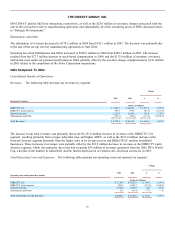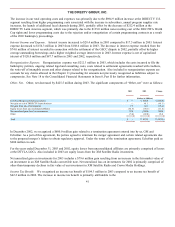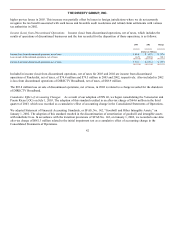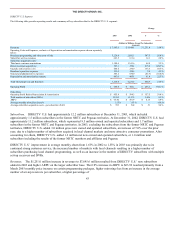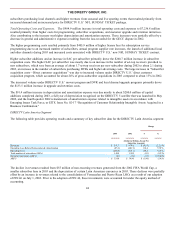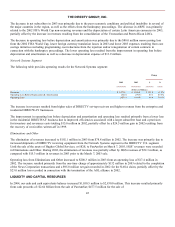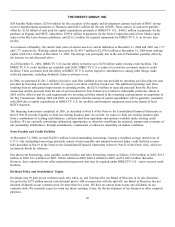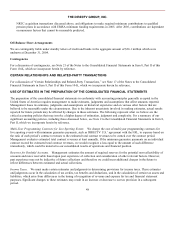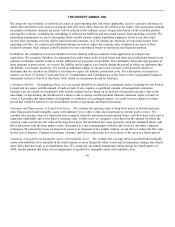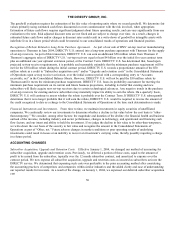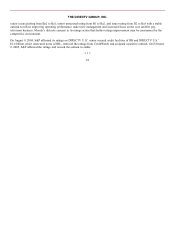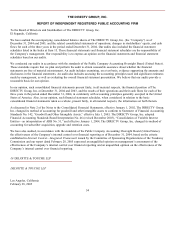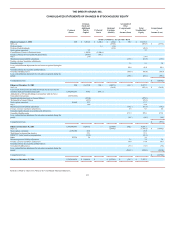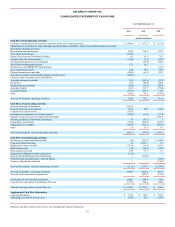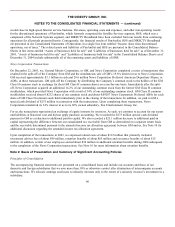DIRECTV 2004 Annual Report Download - page 59
Download and view the complete annual report
Please find page 59 of the 2004 DIRECTV annual report below. You can navigate through the pages in the report by either clicking on the pages listed below, or by using the keyword search tool below to find specific information within the annual report.
THE DIRECTV GROUP, INC.
The goodwill evaluation requires the estimation of the fair value of reporting units where we record goodwill. We determine fair
values primarily using estimated cash flows discounted at a rate commensurate with the risk involved, when appropriate.
Estimation of future cash flows requires significant judgment about future operating results, and can vary significantly from one
evaluation to the next. Risk adjusted discount rates are not fixed and are subject to change over time. As a result, changes in
estimated future cash flows and/or changes in discount rates could result in a write-down of goodwill or intangible assets with
indefinite lives in a future period which could be material to our consolidated results of operations and financial position.
Recognition of Rebate Related to Long-Term Purchase Agreement. As part of our sale of HNS’ set-top receiver manufacturing
operations to Thomson in June 2004, DIRECTV U.S. entered into a long-term purchase agreement with Thomson for the supply
of set-top receivers. As part of this transaction, DIRECTV U.S. can earn an additional $50 million rebate from Thomson if
Thomson’s aggregate sales of DIRECTV U.S.’ set-top receivers equal at least $4 billion over the initial five year contract term
plus an additional one year optional extension period, or the Contract Term. DIRECTV U.S. has determined that, based upon
projected set-top receiver requirements, it is probable and reasonably estimable that the minimum purchase requirement will be
met for the $50 million rebate during the initial contract period. DIRECTV U.S. records a proportionate amount of the $50
million rebate as a credit to “Subscriber acquisition costs” and/or “Upgrade and retention costs” in the Consolidated Statements
of Operations upon set-top receiver activation, over the initial contract period with a corresponding entry to “Accounts
receivable, net” in the Consolidated Balance Sheets. However, DIRECTV U.S. will not be paid the $50 million rebate by
Thomson until it meets the minimum purchase requirement. DIRECTV U.S. bases its probability assessment for meeting the
minimum purchase requirement on its current and future business projections, including its belief that existing and new
subscribers will likely acquire new set-top receivers due to certain technological advances. Any negative trends in the purchase
of set-top receivers for existing and new subscribers may materially impact its ability to earn the rebate. On a quarterly basis,
DIRECTV U.S. will continue to assess whether the rebate is probable over the Contract Term. If DIRECTV U.S. subsequently
determines that it is no longer probable that it will earn the rebate, DIRECTV U.S. would be required to reverse the amount of
the credit recognized to date as a charge to the Consolidated Statements of Operations at the time such determination is made.
Financial Instruments and Investments. From time to time, we maintain investments in equity securities of unaffiliated
companies. We continually review our investments to determine whether a decline in fair value below the cost basis is “other-
than-temporary.” We consider, among other factors: the magnitude and duration of the decline; the financial health and business
outlook of the investee, including industry and sector performance, changes in technology, and operational and financing cash
flow factors; and our intent and ability to hold the investment. If we judge the decline in fair value to be other-than-temporary,
we write-down the cost basis of the security to fair value and recognize the amount in the Consolidated Statements of
Operations as part of “Other, net.” Future adverse changes in market conditions or poor operating results of underlying
investments could result in losses or an inability to recover an investment’s carrying value, thereby possibly requiring a charge
in a future period.
ACCOUNTING CHANGES
Subscriber Acquisition, Upgrade and Retention Costs. Effective January 1, 2004, we changed our method of accounting for
subscriber acquisition, upgrade and retention costs. Previously, we deferred a portion of these costs, equal to the amount of
profit to be earned from the subscriber, typically over the 12 month subscriber contract, and amortized to expense over the
contract period. We now expense all subscriber acquisition, upgrade and retention costs as incurred as subscribers activate the
DIRECTV service. We determined that expensing such costs was preferable to the prior accounting method after considering
the accounting practices of competitors and companies within similar industries and the added clarity and ease of understanding
our reported results for investors. As a result of the change, on January 1, 2004, we expensed our deferred subscriber acquisition
cost
50


